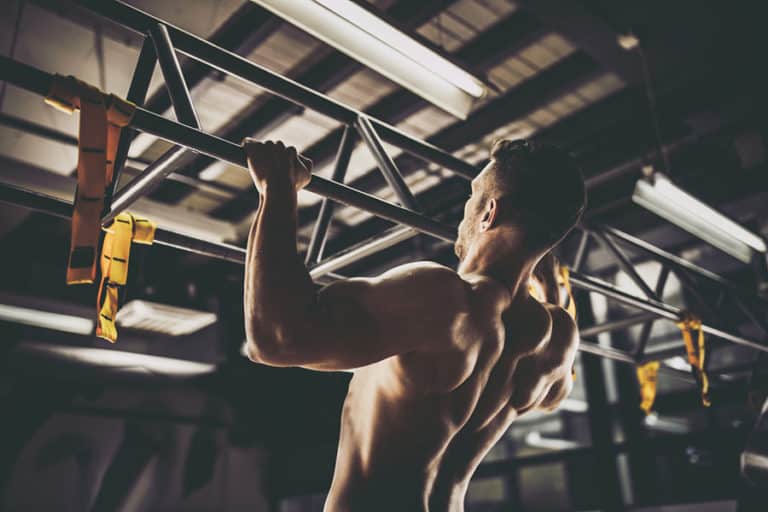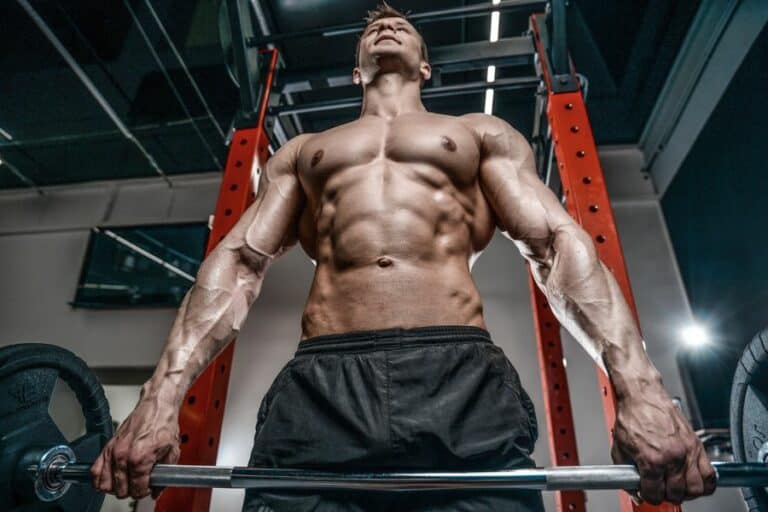Neutral Grip Pull-Ups: Muscles Worked, Benefits, Mistakes

Neutral grip pull ups | How to do | Muscles worked | Close grip vs wide grip | Benefits | Common Mistakes | Variations | Add to routine | FAQs
When considering pull-up exercises, most people tend to think of the traditional pull-up or the chin-up. However, a lesser-known yet equally beneficial variation exists, known as the neutral grip pull-up.
This form of pull-up involves a semi-supinated grip, commonly referred to as a Swiss grip or hammer grip pull-up. This grip helps prevent repetitive strain injuries and is a highly effective exercise for strengthening forearm strength.
What are neutral grip pull-ups?
A neutral grip pull-up is a type of pull-up exercise where the hands are positioned in a semi-supinated grip, with the palms facing each other, much like hammer curls.
Additionally, there are two other types of pull-up grips:
- Pronated (overhand) grip, also known as traditional pull-ups
- Supinated (underhand) grip, also known as chin-ups
Neutral pull-ups are classified as bodyweight multi-joint compound exercises and are often used in functional fitness training programs. They are particularly beneficial for beginners who may find the pronated grip of regular pull-ups challenging.
How to do neutral grip pull-ups?
Here are the steps to perform a neutral grip pull-up:
- Hold onto the parallel pull-up bar with your palms facing each other. Let your body hang down below with your arms extended. This will be your starting position.
- Keep your body straight, core tight, breathe in, and pull yourself up using your arms. Don’t move your arms around too much.
- Lift your chin until it is even with the bar, and pause for a second.
- Lower your chin to the starting position and exhale as you descend.
- Complete 8-10 repetitions, take a 2-minute break and repeat for 3 sets.
Neutral grip pull-up: Muscles worked
Neutral grip pull-ups are an excellent exercise to strengthen your upper body and build your overall fitness.
This exercise engages several muscles in the upper back, middle back, arms, shoulders, core, and abdomen. Let’s take a closer look at the muscles worked during neutral grip pull-ups.
I. Primary muscles worked
The primary muscles activated during neutral grip pull-ups are:
1. Latissimus dorsi muscles
The latissimus dorsi muscles, commonly referred to as the “lats,” are the primary muscles used during a pull-up. These muscles are responsible for pulling and contributing to shoulder extension and adduction.
2. Rectus Abdominis
The rectus abdominis, commonly referred to as the “abs,” are the muscle group responsible for core stability during a pull-up. They assist in maintaining proper form and preventing excessive swinging during the exercise.
3. Brachialis
The brachialis muscle is a small muscle located in the upper arm. It assists in elbow flexion and is activated during the pulling phase of the pull-up.
4. Biceps brachii
The biceps brachii, commonly referred to as the “biceps,” are the muscles responsible for elbow flexion and are activated during the pulling phase of the pull-up.
5. Brachioradialis
During neutral grip pull-ups, the brachioradialis muscle located on the lateral side of the forearm plays a significant role in flexing the forearm and supporting the movements of the biceps brachii. It also helps in pronation and supination of the forearm.
This muscle is especially useful for slow weight lifting with a flexed forearm and quick movements, both essential during pull-ups.
6. Triceps
When performing neutral grip pull-ups, the triceps located at the back of the upper arm are contracted to extend the elbow, stabilize the shoulder, and adduct the arms, aiding in pulling the body up.
7. Traps
The trapezius muscles, commonly referred to as the “traps,” are located in the upper back and neck. They assist in shoulder elevation and stabilization during the pull-up.
8. Rotator Cuff
The rotator cuff muscles are a group of four muscles that originate from the shoulder blade and attach to the humerus. They are responsible for stabilizing the shoulder joint during the pull-up.
9. Rhomboid major
The rhomboid major muscles are located in the upper back and are responsible for shoulder retraction and stabilization during the pull-up.
II. Secondary muscles activated
Here is a list of the secondary muscles that are activated when performing a neutral grip pull-up:
1. Deltoids
The deltoids, commonly referred to as the “delts,” are the muscles located at the top of the shoulder. They are responsible for shoulder abduction and assist in shoulder elevation during the pull-up.2.
2. Pectorals
The pectorals, commonly referred to as the “pecs,” are the muscles located in the chest. They are activated during the pulling phase of the pull-up and assist in stabilizing the shoulder joint.
3. Obliques
The obliques are the muscles located at the sides of the abdomen. They help to maintain proper form during the pull-up and provide stability to the core.
Close grip neutral pull-ups vs. Wide grip neutral pull-ups
Like regular pull-ups, you can perform neutral grip pull-ups with a wide or close grip. Close grip neutral pull-ups and wide grip neutral pull-ups differ in the grip width used during the exercise.
Close grip pull-ups involve gripping the bar with hands placed closer together, while wide grip pull-ups involve gripping the bar with hands wider than shoulder width.
This difference in grip width results in different muscle activations and target areas during the exercise.
Neutral close-grip pull-ups activate the biceps, with assistance from the rhomboid, to strengthen the back and shoulders.
On the other hand, neutral wide-grip pull-ups emphasize the lower lats and shift muscle activation down the back while engaging the traps, abdominal muscles, and obliques.
Benefits of neutral grip pull-ups
Here are some of the main benefits of performing neutral grip pull-ups:
1. Safe pull-up variation
Neutral grip pull-ups provide a safe variation of pull-ups as they offer a natural grip that puts less stress on the wrists and shoulders. It is an excellent option for beginners or those with weak upper body strength who want to progress to regular pull-ups.
2. Builds muscular back
Neutral grip pull-ups activate major back muscle groups, including the latissimus dorsi, rhomboids, and trapezius, making it a compound exercise that strengthens the back.
Additionally, a study [1]ValpaScholar: How Grip Variation Effects Shoulder Complex Muscle Activation During the Pull-Up comparing different grip variations found that the neutral and pronated grip pull-ups result in higher activation of the latissimus dorsi muscle.
3. Improves upper body strength
Regularly performing neutral grip pull-ups can improve upper body strength, including the back, shoulders, arms, and chest, as this challenging exercise requires significant upper body strength.
According to a study [2]PubMed: Electromyographic analysis of muscle activation during pull-up variations on pull-up variations, the neutral grip pull-up activates these muscle groups similarly to regular pull-ups, despite the grip variation.
4. Promotes weight loss
Neutral grip pull-ups can aid in weight loss through increased calorie burn and boosted metabolism. The exercise engages multiple large and small muscles, leading to high caloric expenditure.
Additionally, building muscle through pull-ups leads to a higher metabolic rate, resulting in increased calorie burn even at rest. This makes pull-ups a great addition to a circuit training program for quick and efficient calorie expenditure.
5. Enhances grip
Pull-ups test and develop your forearm and grip strength, which are crucial for various activities like deadlifts, sports, and even everyday tasks. Additionally, grip strength can impact your performance in wrestling or football and even improve your handshake.
Common mistakes to avoid
Some common mistakes to avoid during neutral grip pull-ups include:
1. Swinging
Avoid swinging your body or using momentum to complete the exercise as it takes away the focus from the muscles being targeted and can increase the risk of injury.
2. Incorrect hand placement
Make sure your hands are placed correctly on the bar and that your palms are facing each other during the exercise. Incorrect hand placement can cause discomfort and put unnecessary strain on the wrists.
3. Dropping too quickly
Avoid dropping too quickly after completing a rep, as it can put excessive strain on the shoulders and can lead to injury.
4. Not engaging the core
Neglecting to engage your core can reduce the effectiveness of the exercise and increase the risk of lower back pain.
5. Not completing a full range of motion
Failing to complete a full range of motion can decrease the effectiveness of the exercise and hinder your progress. Make sure to lower yourself fully and extend your arms completely during the exercise.
Variations
Here is a list of pull-up variations you can try:
- Negative pull-ups: Jump or raise yourself up to the bar, then slowly lower your body back down over 5-10 seconds.
- Towel pull-ups: Hang a towel evenly over the bar, grab one end in each hand, and complete a pull-up gripping only the towel.
- Neutral grip scap pull-ups: Start in a dead hang, and pull your shoulder blades down and back to activate the scapular muscles. It requires very little range of motion but works the lats and shoulders to build upper body strength.
- Chest-to-bar pull-ups: Instead of only bringing the chin to the bar, pull the upper body up and over the bar until the chest touches, then lower. This makes things more difficult and is better overall due to the greater range of motion.
- Weighted neutral grip pull-ups: Attach weights to your body or use a weight belt while performing neutral grip pull-ups to increase the intensity and build more strength and muscle.
Adding it to your routine
Here is a sample full-body exercise circuit you can perform that includes neutral grip pull-ups:
| Exercises | Sets x Reps |
| Push-ups | 2-3 sets of 8-10 reps |
| Air squats | 2-3 sets of 8-10 reps |
| Dumbbell squats | 2-3 sets of 8-10 reps |
| Neutral grip pull-ups | 2-3 sets of 8-10 reps |
| Deadlifts | 2-3 sets of 8-10 reps |
| Glute stretches (Cool down) | 2-3 minutes |
Conclusion
Neutral grip pull-ups are a great addition to build upper body strength. They require a proper form to maximize the benefits and avoid injury, so make sure to pay attention to common mistakes. You can get the most out of this exercise with regular practice and varying grip widths and angles.
FAQs
What does a neutral grip pull-up work?
Neutral grip pull-ups work multiple upper body muscles, including the lats, rhomboids, trapezius, biceps, and forearms. With less stress on the shoulders and wrists, this variation is ideal for those with issues in these areas.
Are neutral grip pull-ups better than regular pull-ups?
It depends on the individual and their goals. Regular pull-ups may be better for those looking to build more upper-body strength and muscle. For people with shoulder or wrist issues, neutral grip pull-ups may be more comfortable than regular ones.
Are neutral grip pull-ups the easiest?
Yes, among the pull-up variations, neutral grip pull-ups may be the easiest as they allow for a more natural range of motion and require less strength. However, they should still be performed with the correct technique to ensure optimal results and avoid injury.
References







